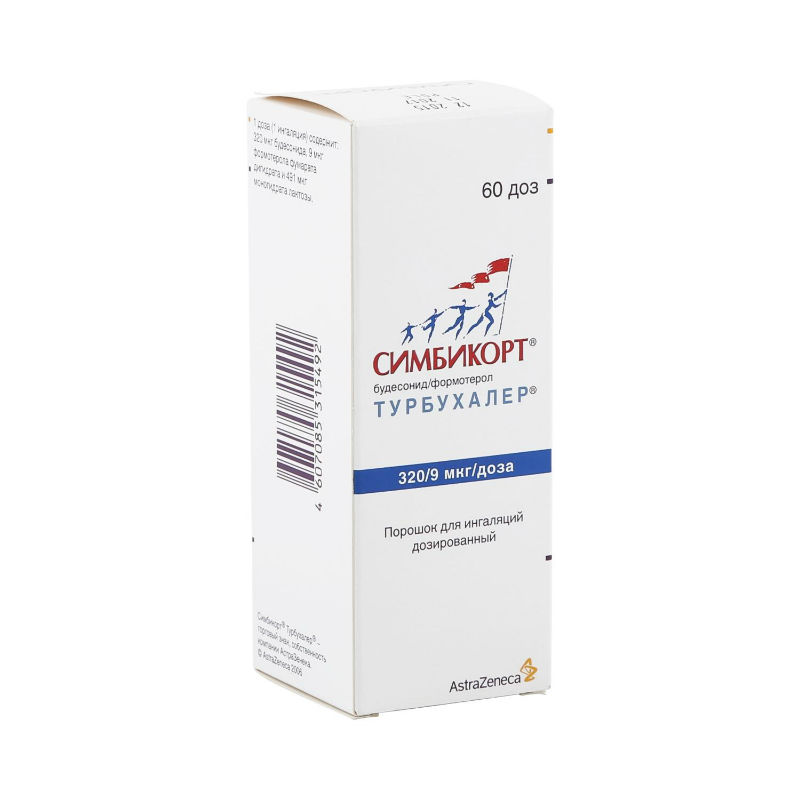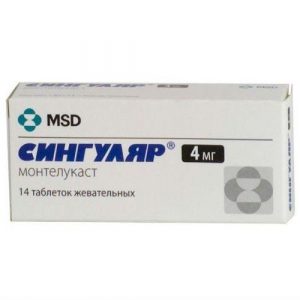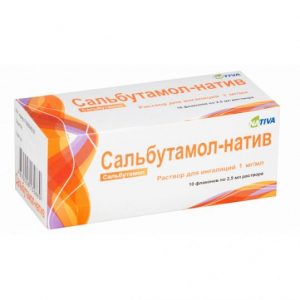Description
Latin name
Simbicort Turbuhaler
Release form
Powder for inhalation in the form of granules from white to almost white, mostly rounded.
Packaging
60-dose vial.
Pharmacological action
Symbicort Turbuhaler – a combined drug for the treatment of bronchial asthma. It contains formoterol and budesonide, which have different mechanisms of action and exhibit an additive effect with respect to reducing the frequency of exacerbations of bronchial asthma.
Budesonide – GCS, after inhalation, has an anti-inflammatory effect on the respiratory tract, which lasts several hours and is dose-dependent. Reduces the severity of symptoms and the frequency of exacerbations of bronchial asthma. With the appointment of budesonide in the form of inhalation, a lower incidence of serious undesirable effects is noted than with systemic corticosteroids. Reduces the severity of edema of the bronchial mucosa, mucus production, sputum formation and respiratory tract hyperresponsiveness. The exact mechanism of the anti-inflammatory action of GCS is not known.
Formoterol is a selective 2-adrenergic receptor agonist. Causes relaxation of the smooth muscles of the bronchi in patients with reversible airway obstruction. The bronchodilator effect is dose-dependent, occurs within 1-3 minutes after inhalation and persists for at least 12 hours after taking a single dose.
In clinical studies, it was found that with the combined use of formoterol and budesonide, the severity of symptoms of bronchial asthma decreases, lung function improves, and the frequency of exacerbations of the disease decreases. The effect of Symbicort Turbuhaler on lung function corresponds to the action of a combination of the single drugs budesonide and formoterol and exceeds the effect of one budesonide. There was no decrease in anti-asthma action over time.
The drug has good tolerance. The drug has good tolerance. While taking Symbicort Turbuhaler as a maintenance therapy for 12 weeks in children aged 6 to 11 years (two inhalations of 80 / 4.5 μg / inhalation 2 times / day), lung function improved and drug tolerance was noted, compared with appropriate dose of budesonide Turbuhaler.
In patients with severe chronic obstructive pulmonary disease (initial FEV1 – 36%) with the use of Symbicort Turbuhaler, there was a significant decrease in the frequency of exacerbations of the disease compared with patients who received only formoterol or placebo as the treatment (average exacerbation rate was 1.4 compared to 1.8- 1.9 in the placebo / formoterol group). There were no differences between taking Symbicort and formoterol with respect to FEV1 values.
Indications
– Bronchial asthma (not adequately controlled by the use of short-acting inhaled corticosteroids and beta2-adrenergic agonists as demanding therapy, or adequately controlled by inhaled corticosteroids and long-acting 2-adrenergic agonists) – as maintenance therapy and for relieving seizures.
– Symptomatic therapy in patients with severe chronic obstructive pulmonary disease.
Contraindications
– Children under 6 years.
– Hypersensitivity to budesonide, formoterol, or inhaled lactose.
Symbicort Turbuhaler should be used with caution in patients with pulmonary tuberculosis (active or inactive forms), with fungal, viral or bacterial infections of the respiratory system, in patients with thyrotoxicosis, pheochromocytoma, diabetes mellitus, uncontrolled hypokalemia, idiopathic hypertrophic hypertrophic hypertrophic hypertrophy , aneurysm of any localization or other severe cardiovascular diseases (IHD, tachyarrhythmia or severe heart failure i) with a prolonged QT interval (formoterol can cause
Pregnancy and lactation
There are no clinical data on the use of Symbicort Turbuhaler or the combined use of formoterol and budesonide during pregnancy.
During pregnancy, Symbicort Turbuhaler should be prescribed only in cases where the expected benefits of therapy to the mother outweigh the potential risk to the fetus.
Budesonide should be used at the lowest effective dose necessary to maintain adequate control of asthma symptoms.
It is not known whether formoterol and budesonide with breast milk are excreted in humans. Symbicort Turbuhaler can be prescribed to nursing women if the expected benefit of the therapy for the mother outweighs the potential risk to the baby.
Composition
1 dose contains:
Active substances:
budesonide 320 mcg,
frmoterol fumarate dihydrate 9 mcg.
Excipients:
lactose monohydrate – 491 mcg.
Dosage and Administration
Inhalation. Dose selection is made individually and depends on the severity of the disease.
Adults and children over 12 years of age: when using an inhalation powder containing budesonide and formoterol in a ratio of 80 μg / 4.5 μg / dose – 1-2 inhalations 2 times a day 160 μg / 4.5 μg / dose – 1-2 inhalations 2 times in a day.
After optimal control of the symptoms of bronchial asthma has been achieved with the administration of the drug 2 times a day, the dose may be reduced to the least effective.
Drug interaction
Taking 200 mg of ketoconazole once a day increases the plasma concentration of 3 mg oral dose of budesonide by an average of 6 times. When prescribing ketoconazole 12 hours after taking budesonide, the concentration of the latter in plasma increases 3 times.
There is no information on such interaction with inhaled budesonide, however, a noticeable increase in the concentration of the drug in plasma should be expected (if it is impossible to exclude such a combination, the interval between the administration of ketoconazole and budesonide should be maximally increased or reduced doses of budesonide). Dr. CYP3A4 inhibitors, probably also can significantly increase the concentration of budesonide in plasma.
Beta-adrenergic receptor blockers (including in the form of eye drops) weaken the effect of formoterol.
Quinidine, disopyramide, procainamide, phenothiazines, antihistamines (terfenadine), MAO inhibitors, and tricyclic antidepressants increase the risk of QT interval prolongation and ventricular arrhythmias. Dopamine, sodium levothyroxine, oxytocin and ethanol reduce the tolerance of beta2-adrenostimulants by the myocardium. MAO inhibitors, furazolidone and procarbazine increase the risk of increased blood pressure.
Halogenated hydrocarbon drugs for general anesthesia increase the risk of arrhythmias. Dr. beta-adrenostimulants increase the severity of side effects of formoterol. Xanthine derivatives, ISS, some diuretics, cardiac glycosides increase the risk of hypokalemia.
Storage conditions
Store at room temperature out of the reach of children.
Expiration
See packaging.
active substance
Budesonide, Formoterol
Terms leave through pharmacies
In retseptu
lekarstvennaja form
powder ynhalyatsyy
Prescription
For pregnant women as prescribed by the doctor, Children over 9 years old, Adults as prescribed by the doctor, Children as prescribed by the doctor, Nursing mothers
Indications
Indications
Indications asthma, Low learning, Bronchospasm
AstraZeneca, United Kingdom




